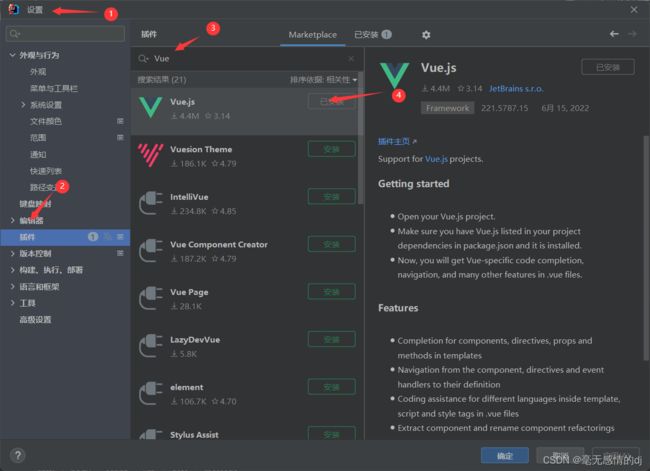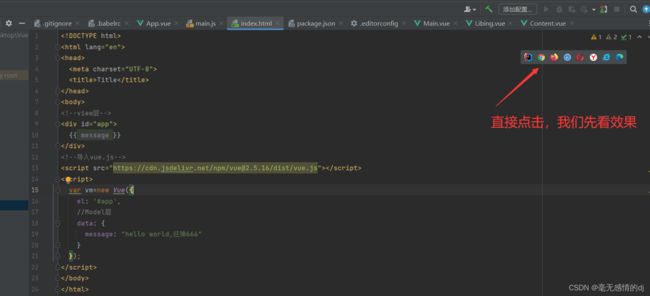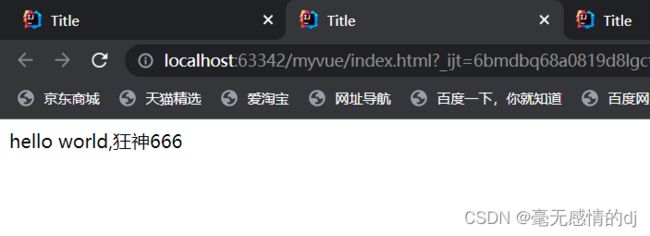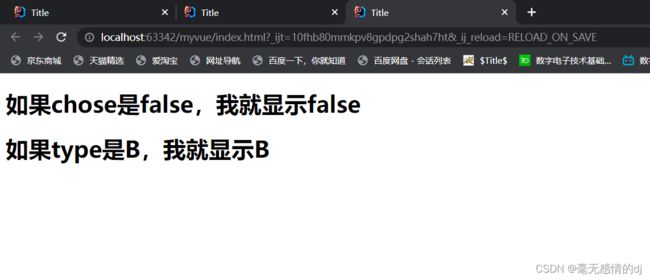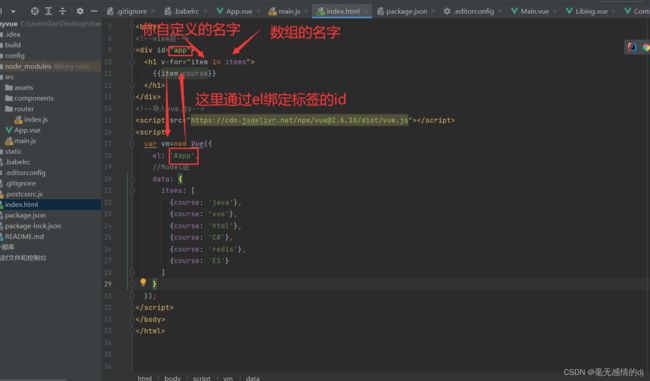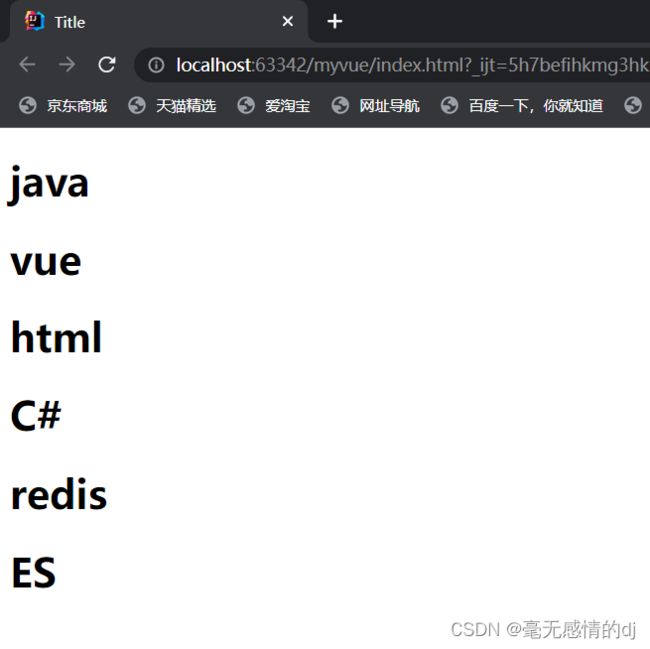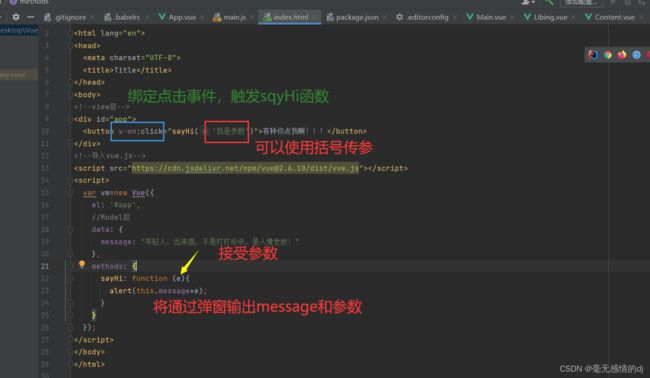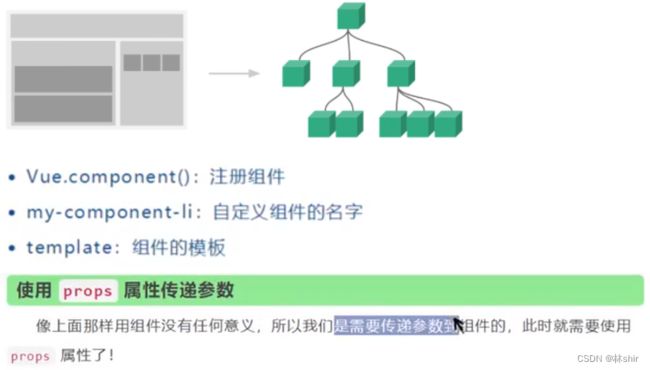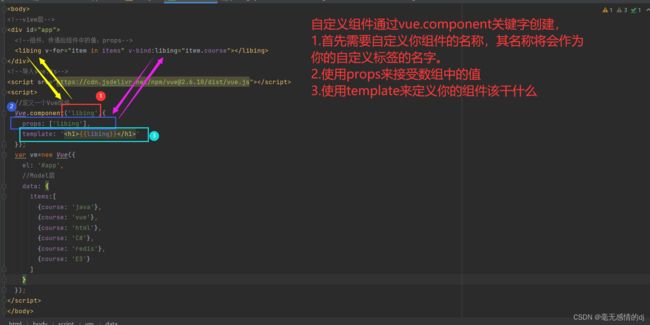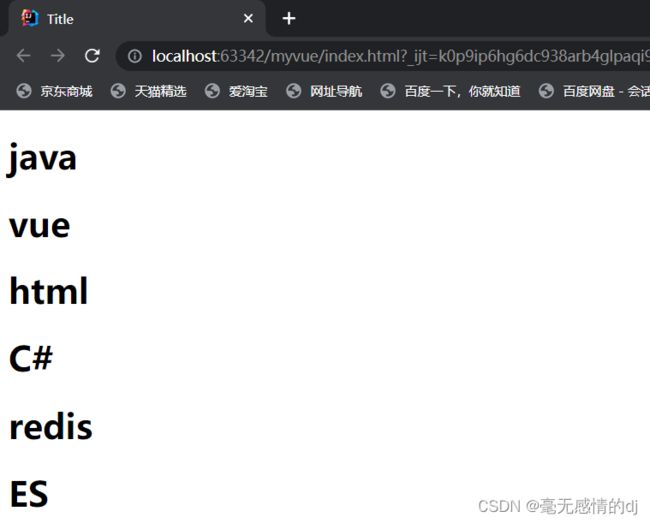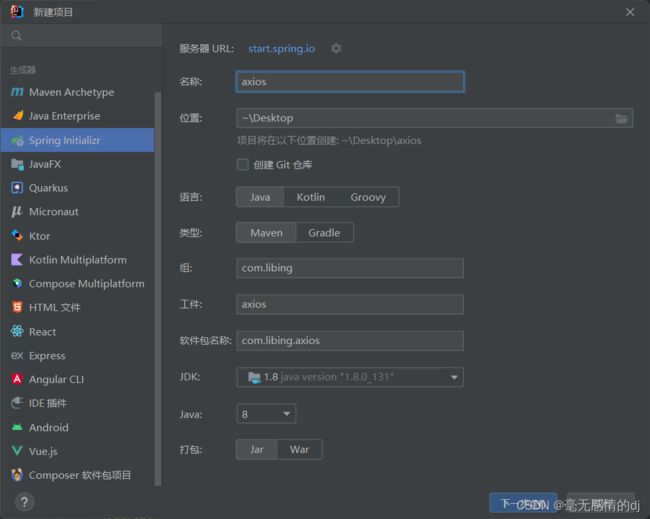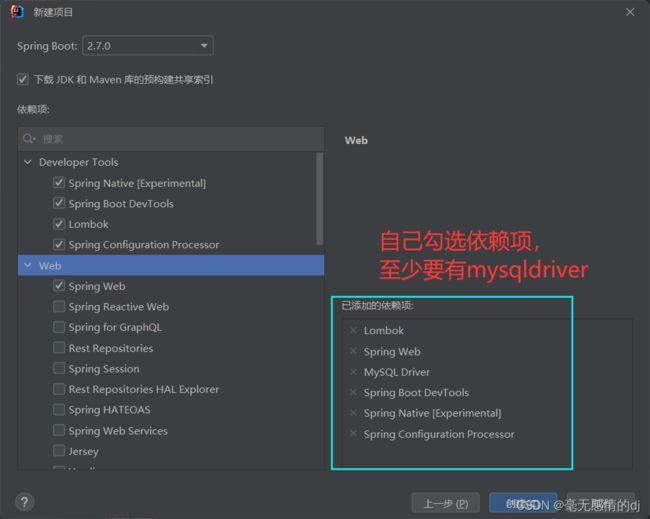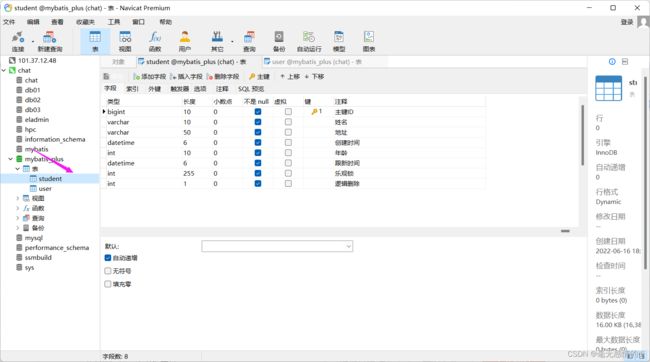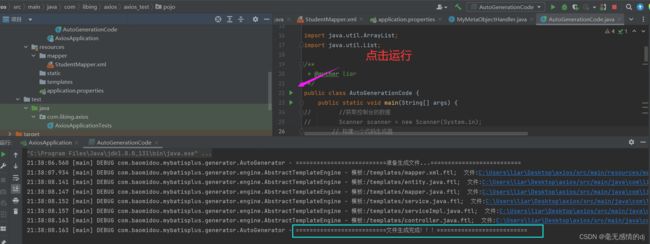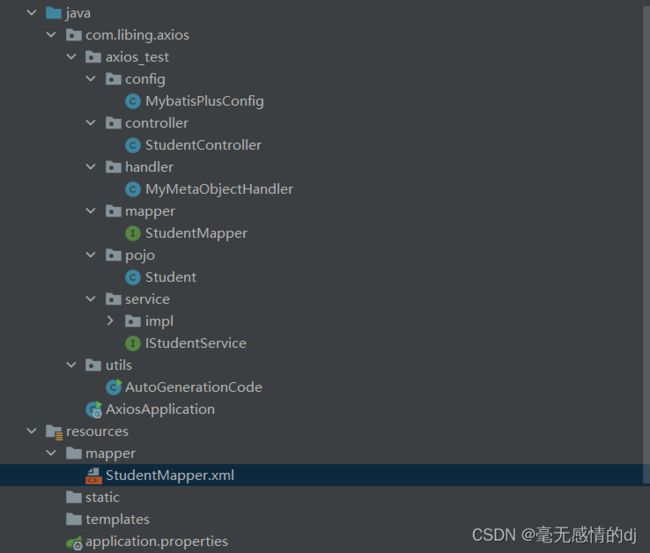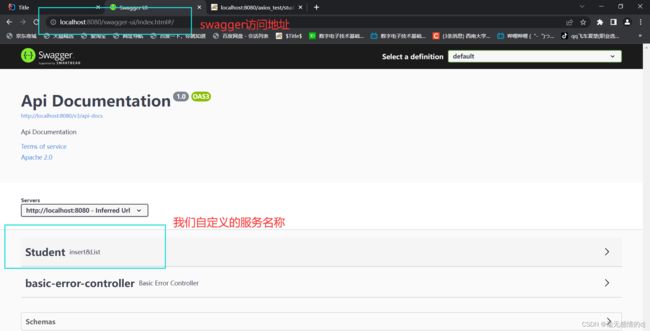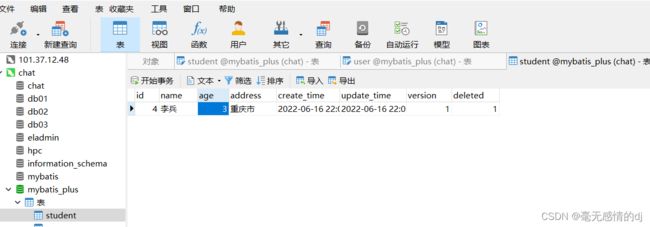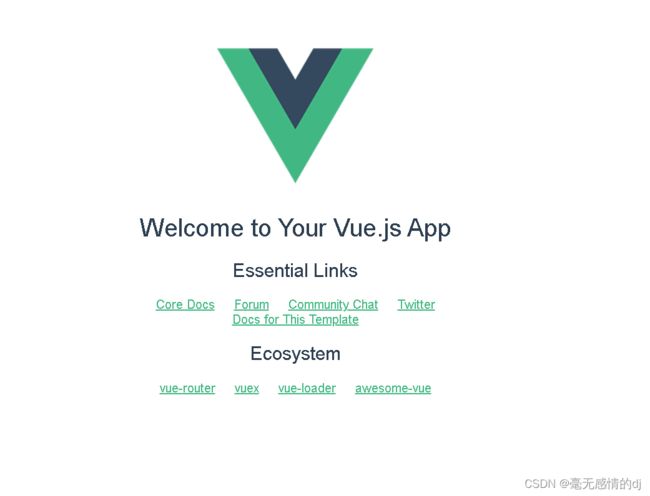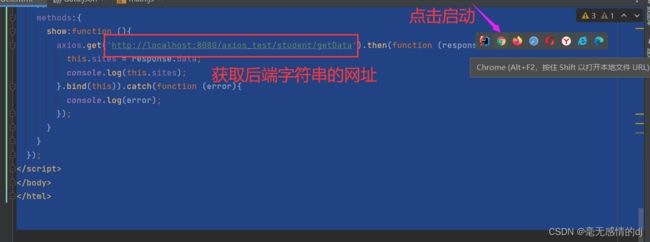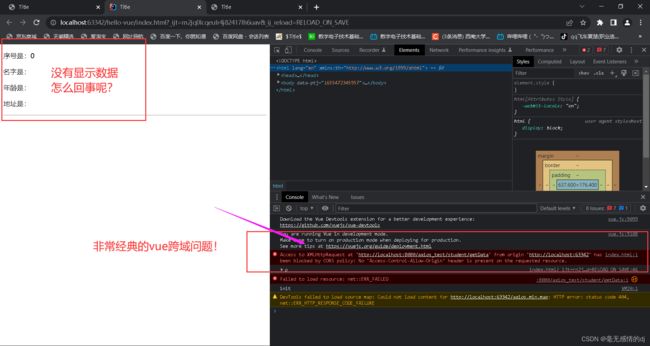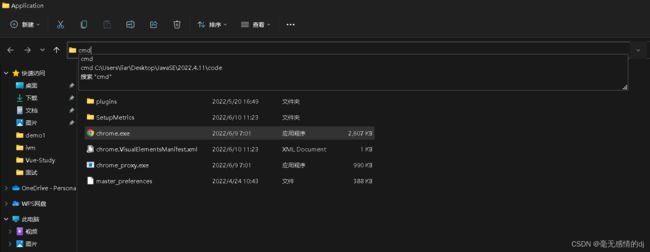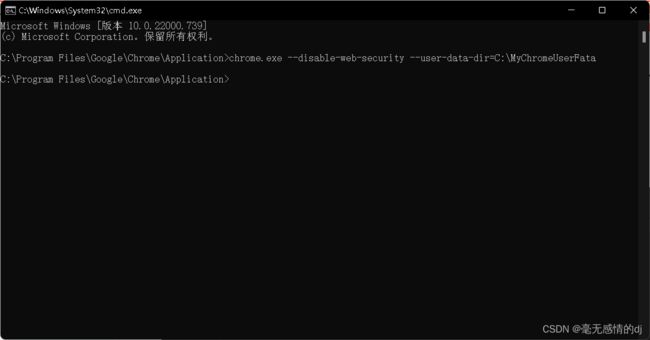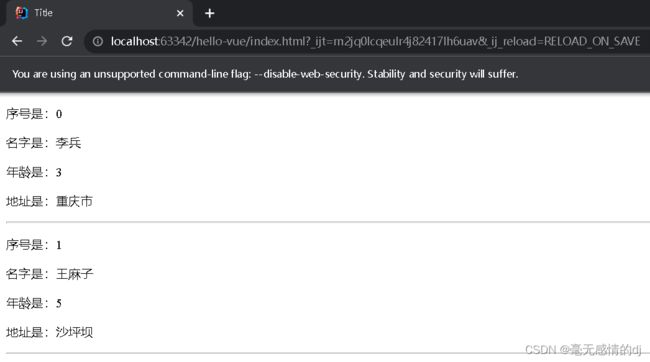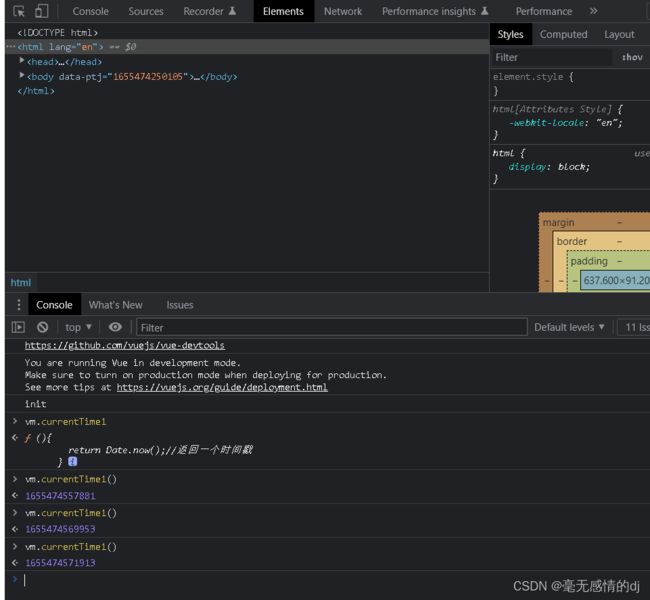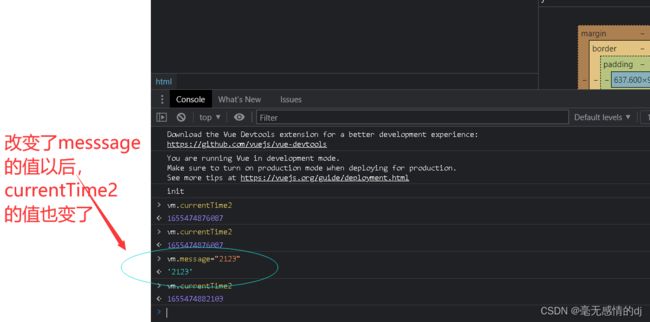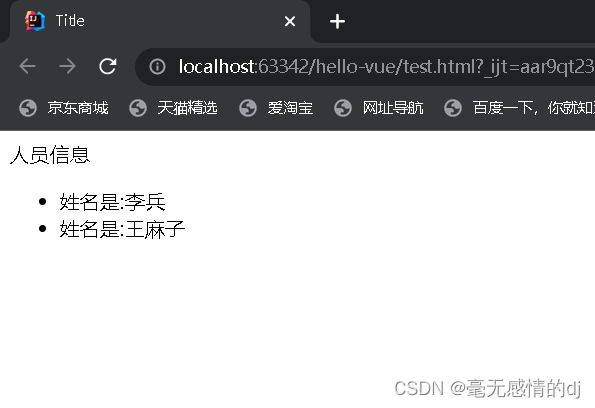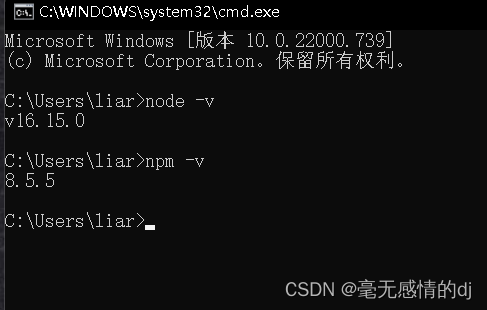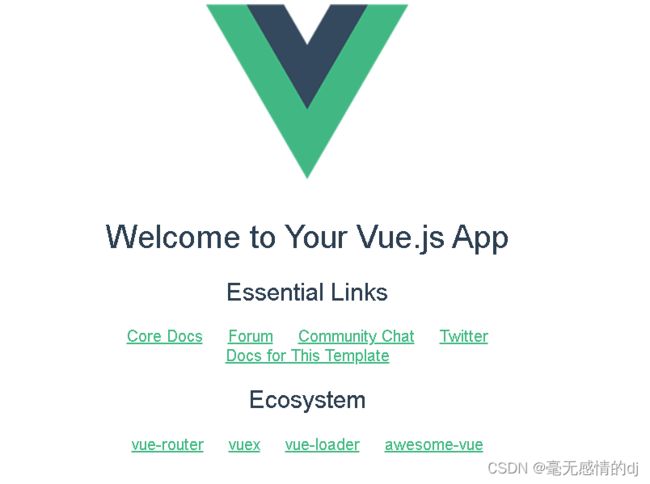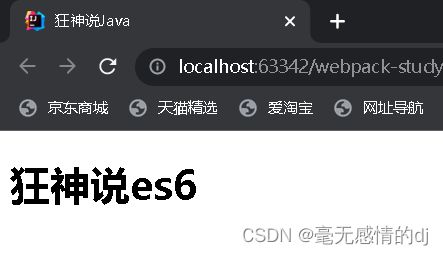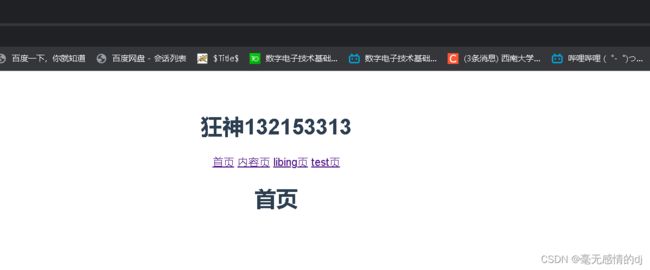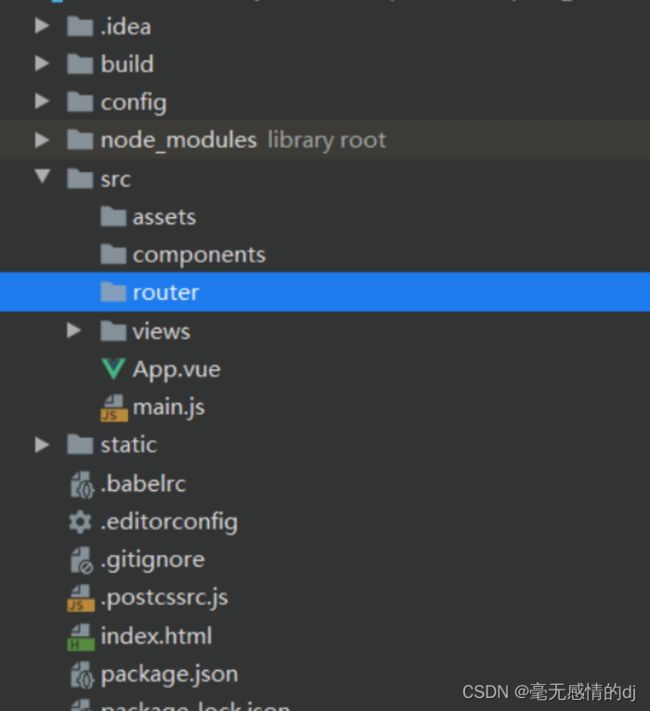基于《狂神说Java》Vue--学习笔记
前言:
本笔记仅做学习与复习使用,不存在刻意抄袭。
------------------------------------------------------------------------------------------------------------
给各位学友强烈推荐《遇见狂神说》他的整套Java学习路线使我获益匪浅!!!
点击跳转至遇见狂神说哔哩哔哩首页
如果你也是狂神的小迷弟,可以加我好友一起探讨学习。
目录
前言:
前端核心分析
VUE概述
前端三要素
JavaScript框架
第一个Vue框架
IDEA 安装Vue插件
Vue的基本语法
简单绑定元素
vue-bind
v-if v-else
v-for
v-on 事件绑定
Vue双向绑定v-model
什么是双向绑定
为什么要实现数据的双向绑定
在表单中使用双向数据绑定
组件(重要)
Axios
什么是Axios
为什么要使用Axios
后端项目
新建一个项目
测试运行
创建数据库
导入依赖
Axios的使用
跨域问题
Vue 计算属性、内容分发、自定义事件
计算属性(重点及特色)
总结
内容分发(插槽)
自定义事件(重点)
Vue入门小结
第一个Vue-cli项目
Vue-cli简介
环境配置
第一个vue-cli应用程序
webpack的使用
安装Webpack
使用webpack
Vue vue-router路由
安装
测试路由
Vue+ElementUI
创建工程
创建登录页面
路由嵌套
参数传递和重定向
参数传递
重定向
路由模式、404和路由钩子
路由模式
404页面
路由钩子
前端核心分析
VUE概述
Vue (读音/vju/, 类似于view)是一套用于构建用户界面的渐进式框架,发布于2014年2月。与其它大型框架不同的是,Vue被设计为可以自底向上逐层应用。Vue的核心库只关注视图层,不仅易于上手,还便于与第三方库(如: vue-router: 跳转,vue-resource: 通信,vuex:管理)或既有项目整合
前端三要素
- HTML (结构) :超文本标记语言(Hyper Text Markup Language) ,决定网页的结构和内容
- CSS (表现) :层叠样式表(Cascading Style sheets) ,设定网页的表现样式
- JavaScript (行为) :是一种弱类型脚本语言,其源代码不需经过编译,而是由浏览器解释运行,用于控制网页的行为
JavaScript框架
- jQuery: 大家熟知的JavaScript框架,优点是简化了DOM操作,缺点是DOM操作太频繁,影响前端性能;在前端眼里使用它仅仅是为了兼容IE6、7、8;
- Angular: Google收购的前端框架,由一群Java程序员开发,其特点是将后台的MVC模式搬到了前端并增加了模块化开发的理念,与微软合作,采用TypeScript语法开发;对后台程序员友好,对前端程序员不太友好;最大的缺点是版本迭代不合理(如: 1代-> 2代,除了名字,基本就是两个东西;截止发表博客时已推出了Angular6)
- React: Facebook出品,一款高性能的JS前端框架;特点是提出了新概念[虚拟DOM]用于减少真实DOM操作,在内存中模拟DOM操作,有效的提升了前端渲染效率;缺点是使用复杂,因为需要额外学习一门[JSX] 语言;
- Vue:一款渐进式JavaScript框架,所谓渐进式就是逐步实现新特性的意思,如实现模块化开发、路由、状态管理等新特性。其特点是综合了Angular (模块化)和React (虚拟DOM)的优点;
- Axios :前端通信框架;因为Vue 的边界很明确,就是为了处理DOM,所以并不具备通信能力,此时就需要额外使用一个通信框架与服务器交互;当然也可以直接选择使用jQuery提供的AJAX通信功能;
- 前端三大框架:Angular、React、Vue
第一个Vue框架
MVVM (Model-View-ViewModel) 是一种软件架构设计模式,由微软WPF (用于替代WinForm,以前就是用这个技术开发桌面应用程序的)和Silverlight (类似于Java Applet,简单点说就是在浏览器上运行的WPF)的架构师Ken Cooper和Ted Peters 开发,是一种简化用户界面的事件驱动编程方式。由John Gossman (同样也是WPF和Silverlight的架构师)于2005年在他的博客上发表。
MVVM 源自于经典的MVC (ModI-View-Controller) 模式。MVVM的核心是ViewModel层,负责转换Model中的数据对象来让数据变得更容易管理和使用,其作用如下:
- 该层向上与视图层进行双向数据绑定
- 向下与Model层通过接口请求进行数据交互
IDEA 安装Vue插件
这里直接在idea设置中安装插件即可:
如果,你用的idea是2020版,且插件搜索不到的,可以安装idea2022最新版。如何破解大家可以自行百度。
Vue的基本语法
好!只要安装了插件其实就可以先写一个简单的页面来感受一下Vue的使用:
我们随便创建一个.html文件就好。
简单绑定元素
Title
{{ message }}
注意,这里是直接用的vue在线cdn:
https://cdn.jsdelivr.net/npm/[email protected]/dist/vue.js
vue-bind
itle绑定message元素使得鼠标悬停可以显示
Title
鼠标悬浮
运行后,鼠标悬停在<鼠标悬浮>就会显示hello world
v-if v-else
其效果类似于java中if,else条件选择语句
Title
如果chose是{{chose}},我就显示{{chose}}
如果chose是{{chose}},我就显示{{chose}}
如果type是{{type}},我就显示{{type}}
如果type是{{type}},我就显示{{type}}
如果type是{{type}},我就显示{{type}}
v-for
看到for,各位就知道这玩意可能跟循环挂钩,它真就是循环,而且代码量极少!
Title
{{item.course}}
结果如下:
v-on 事件绑定
Title
点击按钮后,弹窗显示消息。
Vue双向绑定v-model
什么是双向绑定
Vue.js是一个MVVM框架,即数据双向绑定,即当数据发生变化的时候,视图也就发生变化,当视图发生变化的时候,数据也会跟着同步变化。这也算是Vue.js的精髓之处了。
值得注意的是,我们所说的数据双向绑定,一定是对于UI控件来说的,非UI控件不会涉及到数据双向绑定。单向数据绑定是使用状态管理工具的前提。如果我们使用vuex,那么数据流也是单项的,这时就会和双向数据绑定有冲突。
就像是在输入框中输入数据,下面的元素值显示出来
为什么要实现数据的双向绑定
在Vue.js 中,如果使用vuex ,实际上数据还是单向的,之所以说是数据双向绑定,这是用的UI控件来说,对于我们处理表单,Vue.js的双向数据绑定用起来就特别舒服了。即两者并不互斥,在全局性数据流使用单项,方便跟踪;局部性数据流使用双向,简单易操作。
在表单中使用双向数据绑定
你可以用v-model指令在表单 、 及 元素上创建双向数据绑定。它会根据控件类型自动选取正确的方法来更新元素。尽管有些神奇,但v-model本质上不过是语法糖。它负责监听户的输入事件以更新数据,并对一些极端场景进行一些特殊处理。
注意:v-model会忽略所有元素的value、checked、selected特性的初始值而总是将Vue实例的数据作为数据来源,你应该通过JavaScript在组件的data选项中声明
Title
输入的文本:{{ message }}
性别:男
女
选择了谁:{{luyi}}
下拉框 :
下拉框选中了:{{selected}}
组件(重要)
组件是可复用的Vue实例,说白了就是一组可以重复使用的模板,跟JSTL的自定义标签、Thymeleaf的th:fragment 等框架有着异曲同工之妙。通常一个应用会以一棵嵌套的组件树的形式来组织:
自定义组件在vue中是很重要的知识点,如果你看到这里,希望你配合视频学习,本人作为初学者,可能不能很好的为你讲清楚。
首先先看一下代码:
Title
接下来就是Vue的重头戏了!!
前端如何跟后端产生交互呢,前端将要渲染的数据从哪里来呢?
这里需要讲一下题外话:前后端分离,在前后端分离时代,就是前端,通过发起一个请求,后端接口接受到对应的请求之后,查询到数据库中的数据,将数据转换成Json字符串,再传给前端,这样,前端就能得到数据,然后想干啥就干啥了!
而Vue作为一个纯粹的视图层框架,其是没有内置与后端交互的工具的。
这时Axios就闪亮登场了。
Axios
什么是Axios
Axios是一个开源的可以用在浏览器端和NodeJS 的异步通信框架,她的主要作用就是实现AJAX异步通信,其功能特点如下:
从浏览器中创建XMLHttpRequests
从node.js创建http请求
支持Promise API [JS中链式编程]
拦截请求和响应
转换请求数据和响应数据
取消请求
自动转换JSON数据
客户端支持防御XSRF (跨站请求伪造)
GitHub: https://github.com/ axios/axios
中文文档: http://www.axios-js.com/
为什么要使用Axios
由于Vue.js是一个视图层框架且作者(尤雨溪) 严格准守SoC (关注度分离原则),所以Vue.js并不包含Ajax的通信功能,为了解决通信问题,作者单独开发了一个名为vue-resource的插件,不过在进入2.0 版本以后停止了对该插件的维护并推荐了Axios 框架。少用jQuery,因为它操作Dom太频繁 !
接下来我们就来走一下前后端交互的流程:
后端项目
新建一个项目
测试运行
package com.libing.axios.controller;
import org.springframework.web.bind.annotation.RequestMapping;
import org.springframework.web.bind.annotation.RestController;
/**
* @author liar
*/
@RestController
public class TestController {
@RequestMapping("/test")
public String test(){
return "hello controller";
}
}
ok!项目能正常跑起来,我们就可以写代码了。
创建数据库
如果要问为什么这么创建,详情请看《狂神说Java》mybatis-plus课程。
导入依赖
4.0.0
org.springframework.boot
spring-boot-starter-parent
2.7.0
com.libing
axios
0.0.1-SNAPSHOT
axios
axios
8
0.12.0
org.springframework.boot
spring-boot-starter-web
com.baomidou
mybatis-plus-boot-starter
3.5.1
com.baomidou
mybatis-plus-generator
3.4.1
io.springfox
springfox-swagger2
3.0.0
io.springfox
springfox-swagger-ui
3.0.0
com.alibaba
fastjson
2.0.1
io.springfox
springfox-boot-starter
3.0.0
org.springframework.boot
spring-boot-starter-web
org.springframework.boot
spring-boot-starter-freemarker
org.springframework.boot
spring-boot-devtools
runtime
true
mysql
mysql-connector-java
runtime
org.springframework.boot
spring-boot-configuration-processor
true
org.projectlombok
lombok
true
org.springframework.boot
spring-boot-starter-test
test
com.alibaba
druid
1.1.21
org.springframework.boot
spring-boot-maven-plugin
org.projectlombok
lombok
${repackage.classifier}
paketobuildpacks/builder:tiny
true
spring-releases
Spring Releases
https://repo.spring.io/release
false
spring-releases
Spring Releases
https://repo.spring.io/release
false
native
exec
0.9.11
org.junit.platform
junit-platform-launcher
test
配置application
spring.mvc.pathmatch.matching-strategy=ant_path_matcher
#数据库连接配置
spring.datasource.username=root
spring.datasource.password=root
spring.datasource.url=jdbc:mysql://localhost:3306/mybatis_plus?useSSL=true&useUnicode=true&characterEncoding=UTF-8&serverTimezone=GMT%2B8
spring.datasource.driver-class-name=com.mysql.cj.jdbc.Driver
#配置日志
mybatis-plus.configuration.log-impl=org.apache.ibatis.logging.stdout.StdOutImpl
mybatis-plus.global-config.db-config.logic-delete-field=deleted
mybatis-plus.global-config.db-config.logic-delete-value=0
mybatis-plus.global-config.db-config.logic-not-delete-value=1配置MybatisPlusConfig注册乐观锁插件
package com.libing.axios.axios_test.config;
import com.baomidou.mybatisplus.extension.plugins.MybatisPlusInterceptor;
import com.baomidou.mybatisplus.extension.plugins.inner.OptimisticLockerInnerInterceptor;
import org.mybatis.spring.annotation.MapperScan;
import org.springframework.context.annotation.Bean;
import org.springframework.context.annotation.Configuration;
import org.springframework.transaction.annotation.EnableTransactionManagement;
/**
* @author liar
*/
@MapperScan("com.libing.axios.axios_test.mapper") //扫描mapper文件夹
@EnableTransactionManagement
@Configuration //配置类
public class MybatisPlusConfig {
//注册乐观锁插件
@Bean
public MybatisPlusInterceptor mybatisPlusInterceptor() {
MybatisPlusInterceptor interceptor = new MybatisPlusInterceptor();
interceptor.addInnerInterceptor(new OptimisticLockerInnerInterceptor());
return interceptor;
}
}
配置MyMetaObjectHandler用于填充策略
package com.libing.axios.axios_test.handler;
import com.baomidou.mybatisplus.core.handlers.MetaObjectHandler;
import lombok.extern.slf4j.Slf4j;
import org.apache.ibatis.reflection.MetaObject;
import org.springframework.stereotype.Component;
import java.text.SimpleDateFormat;
import java.util.Date;
/**
* @author liar
*/
@Slf4j
@Component
public class MyMetaObjectHandler implements MetaObjectHandler {
@Override //插入时的填充策略
public void insertFill(MetaObject metaObject) {
log.info("start insert fill");
//setFieldValByName(String fieldName, Object fieldVal, MetaObject metaObject)
this.setFieldValByName("createTime",new Date(),metaObject);
this.setFieldValByName("updateTime",new Date(),metaObject);
}
@Override //跟新时的填充策略
public void updateFill(MetaObject metaObject) {
SimpleDateFormat sdf = new SimpleDateFormat("yyyy-MM-dd HH:mm:ss");
this.setFieldValByName("updateTime",new Date(),metaObject);
}
}
配置自动生成代码工具类AutoGenerationCode
package com.libing.axios.utils;
import com.baomidou.mybatisplus.annotation.DbType;
import com.baomidou.mybatisplus.annotation.FieldFill;
import com.baomidou.mybatisplus.annotation.IdType;
import com.baomidou.mybatisplus.core.toolkit.StringPool;
import com.baomidou.mybatisplus.generator.AutoGenerator;
import com.baomidou.mybatisplus.generator.InjectionConfig;
import com.baomidou.mybatisplus.generator.config.*;
import com.baomidou.mybatisplus.generator.config.po.TableFill;
import com.baomidou.mybatisplus.generator.config.po.TableInfo;
import com.baomidou.mybatisplus.generator.config.rules.NamingStrategy;
import com.baomidou.mybatisplus.generator.engine.FreemarkerTemplateEngine;
import java.util.ArrayList;
import java.util.List;
/**
* @author liar
*/
public class AutoGenerationCode {
public static void main(String[] args) {
// //获取控制台的数据
// Scanner scanner = new Scanner(System.in);
// 构建一个代码生成器
AutoGenerator mpg = new AutoGenerator();
// 全局配置
GlobalConfig gc = new GlobalConfig();
String projectPath = System.getProperty("user.dir");//获取当前目录
gc.setOutputDir(projectPath + "/src/main/java"); //生成文件的输出目录
gc.setAuthor("liar"); //作者
gc.setFileOverride(true); //是否覆蓋已有文件 默认值:false
gc.setOpen(false); //是否打开输出目录 默认值:true
gc.setIdType(IdType.AUTO); //id自增
gc.setSwagger2(true); //自动配置swagger文档
gc.setBaseColumnList(true); //开启 baseColumnList 默认false
gc.setBaseResultMap(true); //开启 BaseResultMap 默认false
// gc.setEntityName("%sEntity"); //实体命名方式 默认值:null 例如:%sEntity 生成 UserEntity
// gc.setMapperName("%sMapper"); //mapper 命名方式 默认值:null 例如:%sDao 生成 UserDao
// gc.setXmlName("%sMapper"); //Mapper xml 命名方式 默认值:null 例如:%sDao 生成 UserDao.xml
// gc.setServiceName("%sService"); //service 命名方式 默认值:null 例如:%sBusiness 生成 UserBusiness
// gc.setServiceImplName("%sServiceImpl"); //service impl 命名方式 默认值:null 例如:%sBusinessImpl 生成 UserBusinessImpl
// gc.setControllerName("%sController"); //controller 命名方式 默认值:null 例如:%sAction 生成 UserAction
//
mpg.setGlobalConfig(gc);
// 数据源配置
DataSourceConfig dsc = new DataSourceConfig();
dsc.setUrl("jdbc:mysql://localhost:3306/mybatis_plus?useUnicode=true&useSSL=false&characterEncoding=utf8");
// dsc.setSchemaName("public");
dsc.setDriverName("com.mysql.cj.jdbc.Driver");
dsc.setUsername("root");
dsc.setPassword("root");
dsc.setDbType(DbType.MYSQL);
mpg.setDataSource(dsc);
// 包配置
PackageConfig pc = new PackageConfig();
pc.setModuleName("axios_test");
// pc.setParent("com.stu");
// String name = scanner.nextLine();
//自定义包配置
pc.setParent("com.libing.axios");
pc.setMapper("mapper");
pc.setEntity("pojo");
pc.setService("service");
// pc.setServiceImpl("service.impl");
pc.setController("controller");
mpg.setPackageInfo(pc);
// 自定义配置
InjectionConfig cfg = new InjectionConfig() {
@Override
public void initMap() {
// to do nothing
}
};
List focList = new ArrayList<>();
focList.add(new FileOutConfig("/templates/mapper.xml.ftl") {
@Override
public String outputFile(TableInfo tableInfo) {
// 自定义输入文件名称
return projectPath + "/src/main/resources/mapper/" + /*pc.getModuleName() + "/" +*/
tableInfo.getEntityName() + "Mapper" +
StringPool.DOT_XML;
}
});
cfg.setFileOutConfigList(focList);
mpg.setCfg(cfg);
mpg.setTemplate(new TemplateConfig().setXml(null));
// 策略配置 数据库表配置,通过该配置,可指定需要生成哪些表或者排除哪些表
StrategyConfig strategy = new StrategyConfig();
strategy.setNaming(NamingStrategy.underline_to_camel); //表名生成策略
strategy.setColumnNaming(NamingStrategy.underline_to_camel);//数据库表字段映射到实体的命名策略, 未指定按照 naming 执行
// strategy.setCapitalMode(true); // 全局大写命名 ORACLE 注意
// strategy.setTablePrefix("prefix"); //表前缀
// strategy.setSuperEntityClass("com.stu.domain"); //自定义继承的Entity类全称,带包名
// strategy.setSuperEntityColumns(new String[] { "test_id", "age" }); //自定义实体,公共字段
strategy.setEntityLombokModel(true); //【实体】是否为lombok模型(默认 false
strategy.setRestControllerStyle(true); //生成 @RestController 控制器
// strategy.setSuperControllerClass("com.baomidou.ant.common.BaseController"); //自定义继承的Controller类全称,带包名
// strategy.setInclude(scanner("表名")); //需要包含的表名,允许正则表达式(与exclude二选一配置)
// System.out.println("请输入映射的表名:");
// String tables = scanner.nextLine();
// String[] num = tables.split(",");
strategy.setInclude("student"); // 需要生成的表可以多张表
// strategy.setExclude(new String[]{"test"}); // 排除生成的表
//如果数据库有前缀,生成文件时是否要前缀acl_
// strategy.setTablePrefix("bus_");
// strategy.setTablePrefix("sys_");
strategy.setLogicDeleteFieldName("deleted");
strategy.setControllerMappingHyphenStyle(true); //驼峰转连字符
strategy.setTablePrefix(pc.getModuleName() + "_"); //是否生成实体时,生成字段注解
//自动填充配置
TableFill createTime = new TableFill("create_time", FieldFill.INSERT);
TableFill updateTime = new TableFill("update_time", FieldFill.INSERT_UPDATE);
ArrayList tableFills = new ArrayList<>();
tableFills.add(createTime);
tableFills.add(updateTime);
strategy.setTableFillList(tableFills);
//乐观锁
strategy.setVersionFieldName("version");
strategy.setControllerMappingHyphenStyle(true); //localhost:8080/hello_id_2
mpg.setStrategy(strategy);
mpg.setTemplateEngine(new FreemarkerTemplateEngine());
mpg.execute();
}
}
如果这里看不懂,建议观看先看视频。【狂神说Java】MyBatisPlus最新完整教程通俗易懂。
可以看到已经帮我们自动生成了代码。而且很规范。
注:这里要确定StudentMapper.xml中字段名与实体类中的字段名一致。
好接下来我们就可以写代码了:
StudentMapper
package com.libing.axios.axios_test.mapper;
import com.libing.axios.axios_test.pojo.Student;
import com.baomidou.mybatisplus.core.mapper.BaseMapper;
import org.apache.ibatis.annotations.Mapper;
import java.util.List;
/**
*
* Mapper 接口
*
*
* @author liar
* @since 2022-06-16
*/
@Mapper
public interface StudentMapper extends BaseMapper {
int setData(int age,String name,String address);
List getData();
}
IStudentService
package com.libing.axios.axios_test.service;
import com.libing.axios.axios_test.pojo.Student;
import com.baomidou.mybatisplus.extension.service.IService;
import java.util.List;
/**
*
* 服务类
*
*
* @author liar
* @since 2022-06-16
*/
public interface IStudentService extends IService {
int setData(int age, String name, String address);
List getData();
}
StudentServiceImpl
package com.libing.axios.axios_test.service.impl;
import com.libing.axios.axios_test.pojo.Student;
import com.libing.axios.axios_test.mapper.StudentMapper;
import com.libing.axios.axios_test.service.IStudentService;
import com.baomidou.mybatisplus.extension.service.impl.ServiceImpl;
import org.springframework.beans.factory.annotation.Autowired;
import org.springframework.stereotype.Service;
import java.util.List;
/**
*
* 服务实现类
*
*
* @author liar
* @since 2022-06-16
*/
@Service
public class StudentServiceImpl extends ServiceImpl implements IStudentService {
@Autowired
private StudentMapper studentMapper;
@Override
public int setData(int age, String name, String address) {
Student student = new Student();
student.setName(name);
student.setAge(age);
student.setAddress(address);
return studentMapper.insert(student);
}
@Override
public List getData() {
return studentMapper.selectList(null);
}
}
StudentController
package com.libing.axios.axios_test.controller;
import com.alibaba.fastjson.JSONArray;
import com.libing.axios.axios_test.service.impl.StudentServiceImpl;
import org.springframework.beans.factory.annotation.Autowired;
import org.springframework.web.bind.annotation.PathVariable;
import org.springframework.web.bind.annotation.RequestMapping;
import org.springframework.web.bind.annotation.RestController;
/**
*
* 前端控制器
*
*
* @author liar
* @since 2022-06-16
*/
@Api( tags = "Student",description = "insert&List")
@RestController
@RequestMapping("/axios_test/student")
public class StudentController {
@Autowired
private StudentServiceImpl studentService;
@RequestMapping("/getData")
public String getData(){
return JSONArray.toJSONString(studentService.getData());
}
@RequestMapping("/setData/{age}/{name}/{address}")
public String setData(
@PathVariable("age") int age,
@PathVariable("name") String name,
@PathVariable("address") String address
){
int result = studentService.setData(age, name, address);
if (result>0){
return "添加成功";
}else {
return "添加失败";
}
}
}
启动类AxiosApplication
package com.libing.axios;
import org.mybatis.spring.annotation.MapperScan;
import org.springframework.boot.SpringApplication;
import org.springframework.boot.autoconfigure.SpringBootApplication;
import springfox.documentation.oas.annotations.EnableOpenApi;
/**
* @author liar
*/
@SpringBootApplication
@EnableOpenApi
@MapperScan("com.libing.axios.axios_test.mapper")
public class AxiosApplication {
public static void main(String[] args) {
SpringApplication.run(AxiosApplication.class, args);
}
}
后端,简单的插入和读取数据接口就写好了,现在我们启动服务测试!
首先我们先看看我们的接口在swagger中有没有显示:
接下来测试插入数据。
现在测试获取数据:
喔!测试成功了,现在可不得了,既然在开启后端服务的情况下访问http://localhost:8080/axios_test/student/getData可以得到json字符串,那我前端直接使用Axios访问这个地址,不就得到数据了,那我再把数据渲染到页面上,就大功告成了!
好的:话不多说,开整!
Axios的使用
这里将创建vue工程以及安装Axios的全流程走一遍,巩固一下基础。
在任意文件夹内打开cmd
输入 vue init webpack 项目名-vue 如vue init webpack hello-vue
接下来会自动下载模板
C:\Users\liar\Desktop\Vue-Study>vue init webpack hello-vue
'git' ڲ ⲿ Ҳ ǿ еij
ļ
? Project name hello-vue //项目名称
? Project description A Vue.js project
? Author liar //作者
? Vue build standalone
? Install vue-router? No //选择no
? Use ESLint to lint your code? No //选择no
? Set up unit tests No //选择no
? Setup e2e tests with Nightwatch? No //选择no
? Should we run `npm install` for you after the project has been created? (recommended) no
vue-cli · Generated "hello-vue".
# Project initialization finished!
# ========================
To get started:
cd hello-vue
npm install (or if using yarn: yarn)
npm run dev
Documentation can be found at https://vuejs-templates.github.io/webpack
#进入工程目录
cd hello-vue
#安装vue-router
cnpm install vue-router --save-dev
#安装element-ui
npm i element-ui -S
#安装依赖
npm install
#安装SASS加载器
cnpm install sass-loader node-sass --save-dev
#启动测试
npm run dev
输入启动后的网址,见到这个页面就ok了。
接下来要么继续使用在线vue和axios要么下载对应的js文件。
我们我们编写index.html
Title
序号是:{{index}}
名字是:{{site.name}}
年龄是:{{site.age}}
地址是:{{site.address}}
跨域问题
首先我们得知道什么是跨域,为什么会产生跨域:
因为浏览器有一个安全机制叫同源策略。同源就是指协议、域名、端口都一样,如果任意一项不一致就是不同源。简单点说就是,你的网页URL和你调用的接口URL不是一个地方的,浏览器觉得有安全风险,不想让你使用这个接口的数据。摘取于:老猿说开发。
举例说明跨域的几种情况:
如果你的页面URL是 http://www.aaa.com/zzz.htm ,那么接口地址如下几种情况
1. https://www.aaa.com/xxx (不同源,因为协议不同)
2. http://www.aaa.com:8080/xxx (不同源,因为端口不同)
3. http://www.bbb.com/xxx (不同源,因为域名不同)
4. http://abc.aaa.com/xxx (不同源,因为域名不同)
5. http://www.aaa.com/xxx (同源,协议、域名、端口均相同)
这里针对跨域问题:提出我使用得最多也是很简单的两种解决方案:
1.编写我们SpringMvcConfiguration配置类:
package com.libing.axios.axios_test.config;
import org.springframework.context.annotation.Configuration;
import org.springframework.web.servlet.config.annotation.CorsRegistry;
import org.springframework.web.servlet.config.annotation.WebMvcConfigurer;
@Configuration
public class SpringMvcConfiguration implements WebMvcConfigurer {
@Override
public void addCorsMappings(CorsRegistry registry) {
registry.addMapping("/**")
.allowedOriginPatterns("*")
.allowedMethods("*")
.allowedHeaders("*")
.allowCredentials(true)
.maxAge(3600);
}
}2.谷歌浏览器解决方案:
- 鼠标右键点击谷歌浏览器图标,选择打开文件所在位置;
- 导航栏输入cmd
- 执行命令:
chrome.exe --disable-web-security --user-data-dir=C:\MyChromeUserFata
然后在跳出来的谷歌页面访问刚才的网址:
喔!成功了呢!
Vue 计算属性、内容分发、自定义事件
计算属性(重点及特色)
计算属性的重点突出在
属性两个字上(属性是名词),首先它是个属性其次这个属性有计算的能力(计算是动词),这里的计算就是个函数:简单点说,它就是一个能够将计算结果缓存起来的属性(将行为转化成了静态的属性),仅此而已;可以想象为缓存。
Title
currentTime1:{{currentTime1()}}
currentTime2:{{currentTime2}}
注意:methods和computed里的东西不能重名,重名之后,只会调用methods的方法
说明:
methods:定义方法, 调用方法使用currentTime1(), 需要带括号
computed:定义计算属性, 调用属性使用currentTime2, 不需要带括号:this.message是为了能够让currentTime2观察到数据变化而变化
如何在方法中的值发生了变化,则缓存就会刷新!可以在控制台使用vm.message 改变下数据的值,再次测试观察效果!
总结
调用方法时,每次都需要讲行计算,既然有计算过程则必定产生系统开销,那如果这个结果是不经常变化的呢?此时就可以考虑将这个结果缓存起来,采用计算属性可以很方便的做到这点,计算属性的主要特性就是为了将不经常变化的计算结果进行缓存,以节约我们的系统开销。
内容分发(插槽)
在
Vue.js中我们使用`元素作为承载分发内容的出口,可以称其为插槽,可以应用在组合组件的场景中。
需求:需要把下面的内容,让标题和内容通过插槽插入内容
标题
- abcd
- abcd
- abcd
- 定义一个代办事情的组件
Vue.component('todo',{
template:'\
代办事项\
\
- kuangshen study Java
\
\
'
});
- 将上面的代码留出一个插槽,即slot
Vue.component('todo',{
template:'\
\
\
\
\
'
});
- 定义一个名为todo-title的待办标题组件 和 todo-items的待办内容组件
Vue.component('todo-title',{
props:['title'],
template:'{{title}}'
});
//这里的index,就是数组的下标,使用for循环遍历的时候,可以循环出来!
Vue.component("todo-items",{
props:["item","index"],
template:"{{index+1}},{{item}} "
});
- slot通过name和组件绑定
Vue.component('todo',{
template:'\
\
\
'
});
- 实例化Vue并初始化数据
var vm = new Vue({
el:"#vue",
data:{
title: '人员信息',
info:[
{
name: '',
age: '',
address: ''
}
]
},
mounted(){
axios.get('http://localhost:8080/axios_test/student/getData').then(response=>(this.info = response.data))
}- 将数据通过插槽插入预留出来的位置
说明:
slot:是绑定组件用的
:title --> 是v-bind:title的缩写
- 完整代码
Title
其运行长这样:
自定义事件(重点)
通过上诉代码我们可以发现一个问题,如果删除操作要在组件中完成,那么组件如何删除Vue实例中的数据?
删除按钮是在组件中的,点击删除按钮删除对应的数据。
阅读Vue教程可知,此时就涉及到参数传递与事件分发了, Vue为我们提供了自定义事件的功能很好的帮助我们解决了这个问题; 组件中使用this.$emit(‘自定义事件名’, 参数) ,而在视图层通过自定义事件绑定Vue中的删除操作的方法
Title
这里我很难为读者讲清楚:详情请见狂神视频。
Vue入门小结
核心:数据驱动,组件化
优点:借鉴了AngularJS的模块化开发和React的虚拟Dom,虚拟Dom就是把Demo操作放到内存中执行;
常用的属性:
- v-if
- v-else-if
- v-else
- v-for
- v-on绑定事件,简写@
- v-model数据双向绑定
- v-bind给组件绑定参数,简写:
组件化:
- 组合组件slot插槽
- 组件内部绑定事件需要使用到this.$emit(“事件名”,参数);
- 计算属性的特色,缓存计算数据
遵循SoC关注度分离原则,Vue是纯粹的视图框架,并不包含,比如Ajax之类的通信功能,为了解决通信问题,我们需要使用Axios框架做异步通信;
第一个Vue-cli项目
Vue-cli简介
vue-cli官方提供的一个脚手架,用于快速生成一个vue的项目模板
预先定义好的目录结构及基础代码,就好比咱们在创建Maven项目时可以选择创建一个骨架项目,这个估计项目就是脚手架,我们的开发更加的快速
项目的功能
- 统一的目录结构
- 本地调试
- 热部署
- 单元测试
- 集成打包上线
环境配置
- Node.js
下载地址: http://nodejs.cn/download/ 安装的时候一直下一步直到结束
确认是否安装成功:
- 在cmd中运行node -v命令,查看是否能够输出版本号
- 在cmd中运行npm -v命令,查看是否能够输出版本号
- 安装node.js淘宝镜像加速器(cnpm)
# -g 就是全局安装
npm install cnpm -g
# 或使用如下语句解决npm速度慢的问题,但是每次install都需要(麻烦)
npm install --registry=https://registry.npm.taobao.org
cnpm instal1 vue-cli-g
#测试是否安装成功#查看可以基于哪些模板创建vue应用程序,通常我们选择webpack
vue list
第一个vue-cli应用程序
-
找到一个项目路径(空文件夹)
-
创建一个基于webpack模板的vue应用程序
#1、首先需要进入到对应的目录 cd E:\study\Java\workspace\workspace_vue
#2、这里的myvue是顶日名称,可以根据自己的需求起名
vue init webpack myvue
创建过程需要的操作
一路选no
Project name:项目名称,默认回车即可
Project description:项目描述,默认回车即可
Author:项目作者,默认回车即可
Install vue-router:是否安装vue-router,选择n不安装(后期需要再手动添加)
Use ESLint to lint your code:是否使用ESLint做代码检查,选择n不安装(后期需要再手动添加)
Set up unit tests:单元测试相关,选择n不安装(后期需要再手动添加)
Setupe2etests with Nightwatch:单元测试相关,选择n不安装(后期需要再手动添加)
Should we run npm install for you after the,project has been created:创建完成后直接初始化,选择n,我们手动执行;运行结果
当出现问题时,它会给出提示我们按照提示来就行。
- 初始化并运行
cd myvue
npm install
npm run dev
![]()
访问localhost:8080
看到这个页面就是成功了。
webpack的使用
安装Webpack
WebPack是一款模块加载器兼打包工具, 它能把各种资源, 如JS、JSX、ES 6、SASS、LESS、图片等都作为模块来处理和使用
安装:
npm install webpack -g
npm install webpack-cli -g
测试安装成功:
webpack -v
webpack-cli -v
配置:
entry:入口文件, 指定Web Pack用哪个文件作为项目的入口
output:输出, 指定WebPack把处理完成的文件放置到指定路径
module:模块, 用于处理各种类型的文件
plugins:插件, 如:热更新、代码重用等
resolve:设置路径指向
watch:监听, 用于设置文件改动后直接打包
module.exports = {
entry:"",
output:{
path:"",
filename:""
},
module:{
loaders:[
{test:/\.js$/,;\loade:""}
]
},
plugins:{},
resolve:{},
watch:true
}
使用webpack
- 创建项目
在workspace中创建文件夹webpack-study,然后用IDEA打开
- 创建一个名为modules的目录,用于放置JS模块等资源文件
- 在modules下创建模块文件hello.js
//暴露一个方法
exports.sayHi = function(){
document.write("狂神说es6
")
}- 在modules下创建一个名为main.js的入口文件main.js,用于打包时设置entry属性
//require 导入一个模块,就可以调用这个模块中的方法了
var hello = require("./hello");
hello.sayHi();
- 在项目目录下创建webpack.config.js配置文件,使用webpack命令打包
module.exports = {
entry:"./modules/main.js",
output:{
filename:"./js/bundle.js"
}
}
打包:
说明:打包如果失败,就用管理员权限运行webpack
- 在项目目录下创建HTML页面,如index.html,导入webpack打包后的JS文件
狂神说Java
运行结果是:
注:
# 参数--watch 用于监听变化,如果要打包的东西有变化,就重新打包
webpack --watch
Vue vue-router路由
安装
- 基于第一个
vue-cli进行测试学习; 先查看node modules中是否存在vue-router, vue-router是一个插件包, 所以我们还是需要用n pm/cn pm来进行安装的
npm install vue-router --save-dev
- 如果在一个模块化工程中使用它,必须要通过Vue.use()明确地安装路由功能
import Vue from 'vue'
import VueRouter from 'vue-router'
Vue.use(VueRouter);
测试路由
- 删除第一个vue-cli项目中的没用的东西
components目录下存放我们自己编写的组件- 定义几个自己的组件 Content.vue 、Main.vue、Test.vue
Content.vue
内容页
Main.vue
首页
Test.vue
测试页
- 安装路由,在src目录下,新建一个文件夹:
router,专门存放路由,配置路由index.js
import Vue from 'vue'
import VueRouter from 'vue-router'
import Test from "../components/Test";
import Content from '../components/Content'
import Main from '../components/Main'
import Libing from '../components/Libing'
//安装路由
Vue.use(VueRouter);
//配置导出路由
export default new VueRouter({
routes: [
{
//路由路径
path: '/content',
//名称,可以不写
name: 'content',
//跳转的组件
component: Content
},
{
//路由路径
path: '/main',
name: 'main',
//跳转的组件
component: Main
},
{
//路由路径
path: '/libing',
name: 'libing',
//跳转的组件
component: Libing
},
{
//路由路径
path: '/test',
name: 'test',
//跳转的组件
component: Test
}
]
});
- 在
main.js中配置路由
// The Vue build version to load with the `import` command
// (runtime-only or standalone) has been set in webpack.base.conf with an alias.
import Vue from 'vue'
import App from './App'
import router from './router'//自动扫描里面的路由配置
Vue.config.productionTip = false
/* eslint-disable no-new */
new Vue({
el: '#app',
//配置路由
router,
components: { App },
template: '- 在
App.vue中使用路由
狂神132153313
首页
内容页
libing页
test页
运行npm run dev,然后浏览器访问localhost:8080
点击对应的标签,可以跳转到对应页面。
Vue+ElementUI
创建工程
- 创建一个名为hello-vue的工程
vue init webpack hello-vue
- 安装依赖, vue-router、element-ui、sass-loader和node-sass四个插件
#进入工程目录
cd hello-vue
#安装vue-routern
npm install vue-router --save-dev
#安装element-ui
npm i element-ui -S
#安装依赖
npm install
# 安装SASS加载器
cnpm install sass-loader node-sass --save-dev
#启功测试
npm run dev
- npm命令说明
npm install moduleName:安装模块到项目目录下
npm install -g moduleName:-g的意思是将模块安装到全局,具体安装到磁盘哪个位置要看npm
config prefix的位置
npm install -save moduleName:–save的意思是将模块安装到项目目录下, 并在package文件的dependencies节点写入依赖,-S为该命令的缩写
npm install -save-dev moduleName:–save-dev的意思是将模块安装到项目目录下,并在package文件的devDependencies节点写入依赖,-D为该命令的缩写
- idea打开创建好的项目
创建登录页面
目录结构:
说明:
- assets:用于存放资源文件
- components:用于存放Vue功能组件
- views:用于存放Vue视图组件
- router:用于存放vue-router配置
- 在views目录下创建首页视图Main.vue组件
首页
- 在views目录下创建登录页面视图Login.vue组件
欢迎登录
登录
请输入账号和密码
- 在router目录下创建一个名为
index.js的vue-router路由配置文件
//导入vue
import Vue from 'vue';
import VueRouter from 'vue-router';
//导入组件
import Main from "../views/Main";
import Login from "../views/Login";
//使用
Vue.use(VueRouter);
//导出
export default new VueRouter({
routes: [
{
//登录页
path: '/main',
component: Main
},
//首页
{
path: '/login',
component: Login
},
]
})
- 编写 APP.vue
- 在
main.js中配置路由
import Vue from 'vue'
import App from './App'
import router from "./router"
import ElementUI from 'element-ui'
import 'element-ui/lib/theme-chalk/index.css'
Vue.config.productionTip = false
Vue.use(router)
Vue.use(ElementUI)
/* eslint-disable no-new */
new Vue({
el: '#app',
router,
render:h=>h(App)
})
- 测试npm run dev
说明: 如果出现错误: 可能是因为sass-loader的版本过高导致的编译错误 ,可以去package.json文件中把sass-loder的版本降低,也有可能是node-sass版本过高,看报错内容修改相应的版本
路由嵌套
嵌套路由又称子路由,在实际应用中,通常由多层嵌套的组件组合而成
- 创建用户信息组件,在 views/user 目录下创建一个名为 Profile.vue 的视图组件
个人信息
- 在用户列表组件在 views/user 目录下创建一个名为 List.vue 的视图组件
用户列表
- 修改首页视图,我们修改 Main.vue 视图组件,此处使用了 ElementUI 布局容器组件
用户管理
个人信息
用户列表
内容管理
分类管理
内容列表
个人信息
退出登录
- 添加了组件,去router修改配置文件
//导入vue
import Vue from 'vue';
import VueRouter from 'vue-router';
//导入组件
import Main from "../views/Main";
import Login from "../views/Login";
//导入子模块
import UserList from "../views/user/List";
import UserProfile from "../views/user/Profile";
//使用
Vue.use(VueRouter);
//导出
export default new VueRouter({
routes: [
{
//登录页
path: '/main',
component: Main,
// 写入子模块
children: [
{
path: '/user/profile',
component: UserProfile,
}, {
path: '/user/list',
component: UserList,
},
]
},
//首页
{
path: '/login',
component: Login
},
]
})
参数传递和重定向
参数传递
- 修改路由配置, 主要是router下的index.js中的 path 属性中增加了 :id 这样的占位符
{
path: '/user/profile/:id',
name:'UserProfile',
component: UserProfile
}
- 视图层传递参数
个人信息
说明: 此时我们在Main.vue中的route-link位置处 to 改为了 :to,是为了将这一属性当成对象使用,注意 router-link 中的 name 属性名称 一定要和 路由中的 name 属性名称 匹配,因为这样 Vue 才能找到对应的路由路径
- 接收参数
个人信息
{{$route.params.id}}
说明:所有的元素必须在根节点下面,否则会报错
使用props 减少耦合
- 修改路由配置 , 主要在router下的index.js中的路由属性中增加了 props: true 属性
{
path: '/user/profile/:id',
name:'UserProfile',
component: UserProfile,
props: true
}
- 传递参数和之前一样
- 在Profile.vue接收参数为目标组件增加 props 属性
个人信息
{{ id }}
重定向
Vue 中的重定向是作用在路径不同但组件相同的情况
- 在router/index.js配置重定向路径
{
path: '/main',
name: 'Main',
component: Main
},
{
path: '/goHome',
redirect: '/main'
}
- 视图增加
返回首页
路由模式、404和路由钩子
路由模式
路由模式有两种
- hash:路径带 # 符号,如 http://localhost/#/login
- history:路径不带 # 符号,如 http://localhost/login
修改路由配置
export default new VueRouter({
mode:'history',
routes: []
)}
在路由的配置中修改
404页面
- 创建一个NotFound.vue视图
404,你的页面走丢了
- 修改路由配置index.js
import NotFound from '../views/NotFound'
{
path: '*',
component: NotFound
}
路由钩子
除了之前的钩子函数还存在两个钩子函数
beforeRouteEnter:在进入路由前执行
beforeRouteLeave:在离开路由前执行
- 在 Profile.vue 使用
参数说明:
to:路由将要跳转的路径信息
from:路径跳转前的路径信息
next:路由的控制参数
next() 跳入下一个页面
next(’/path’) 改变路由的跳转方向,使其跳到另一个路由
next(false) 返回原来的页面
next((vm)=>{}) 仅在 beforeRouteEnter 中可用,vm 是组件实例
在钩子函数中进行异步请求
- 安装Axios
cnpm install --save vue-axios
- main.js引用 Axios
import axios from 'axios'
import VueAxios from 'vue-axios'
Vue.use(VueAxios, axios)
{
"name": "cv战士",
"url": "https://blog.csdn.net/qq_45408390?spm=1001.2101.3001.5343",
"page": 1,
"isNonProfit": true,
"address": {
"street": "含光门",
"city": "陕西西安",
"country": "中国"
},
"links": [
{
"name": "bilibili",
"url": "https://bilibili.com"
},
{
"name": "cv战士",
"url": "https://blog.csdn.net/qq_45408390?spm=1001.2101.3001.5343"
},
{
"name": "百度",
"url": "https://www.baidu.com/"
}
]
}
说明: 只有我们的 static 目录下的文件是可以被访问到的,所以我们就把静态文件放入该目录下
- 在 beforeRouteEnter 中进行异步请求
到此就结束了,再次声明,此文,只作本人复习使用。如有侵权,请联系我,将妥善处理。
